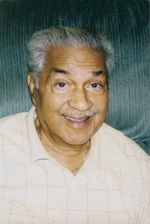Dr Cordice, a Pioneer in Public Health

Dr Gideon Cordice is an outstanding Vincentian of East Indian heritage. He is the person attributed with the elimination of yaws in St. Vincent and the Grenadines. Doc, as he is affectionately called, has been described as a pioneer in public health and for decades headed the public health department here.
{{more}}
In addition to this, for many years Dr. Cordice was the resident physician at the Psychiatric hospital. He also served as the Chief Medical Officer and was president of the medical association until he retired from active service in 1978.
Doc is known for his compassion, and many of the patients seen in his private clinic were not charged. Money was never the motivating factor for this unsung hero.
Docâs paternal grandfather John Balusingh came to St. Vincent from the North Punjab area of India during indentureship.
Balusingh lived at Lot 14, a village just beyond the Rabacca River on the Windward Side of the island. Dr. Cordice recalls that his grandfather Balusingh was well-off, and his wife wore jewelry âfrom her armpits to her fingertips.â Balusingh was able to accumulate much of his wealth because of his close relationship with the army colonel stationed in that area.
One of Balusinghâs sons was named John Fordyce, another Bhudu Richards. Fordyce and Richards were brothers by both mother and father, but each carried the surname of his Godfather, as was the practice. This was so because of the difficulty experienced locally in spelling the Indian names. Over the years, the name Fordyce got corrupted and became Cordice. John Fordyce (Cordice) was Docâs father.
John Cordice married Ellen McDowall, and they had six children, three boys and three girls. Doc Cordice was the last child. He was born in 1924. His other siblings were Christine, Conrad (Fatty), Agnes, Belle (mother of Frankie McIntosh) and Cameron. Doc recalls having a privileged childhood as his mother Ellen was the daughter of a wealthy man. Docâs father John âPapaâ Cordice, was an estate owner and ran shops at Byrea Hill and Grand Sable.
Doc and his brothers all attended the Boysâ Grammar School in Kingstown. The girls, however, did not go to secondary school, as according to Doc, âIn those days, them Indians wasnât sending their girls out to town.â While he was at secondary school, he lived with his sister Christine at North River Road. Christine was like a mother to Doc, as his mother Ellen had died when he was only 9 years old. Christine was married to legendary educator Bertram âTimmyâ Richards.
At the Grammar School, Doc was head boy and excelled academically. He was also an avid cricketer. In 1944, he won the lone Island Scholarship. But according to Doc, that almost did not happen. He recalls that one day when he was in Form 6A, one of his classmates, Hadley, while passing through the Girlsâ High School compound, overheard the Headmistress of that school, Mrs. Moffett and a parent discussing the schoolâs chances of winning the island scholarship that year. The Headmistress opined, âWe have it in the bag. Donât worry with Cordice, all he studying is to play cricket on the park.â Hadley ran over to Grammar School and called a class meeting. The boys vowed to beat the girls that year. Doc is grateful that his friend Hadley overheard that conversation that day. âI donât believe we would have made the grade otherwise.â
The Grammar School Headmaster, Don Lopey wanted Cordice to study law, as Cordice had impressed him with his debating skills. Young Cordice was adamant that he did not want to enter that profession. His opinion about lawyers was formed early in life when he saw how they dealt with a land dispute between his father and a neighbour. He vowed then, âhe would never be a lawyer in this life.â
When Gideon got the news about the island scholarship, he says he went âon a celebration. Strong rum to kill. Every night strong rum and coconut water.â
He entered medical school in Aberdeen, Scotland in 1945, and graduated in 1950. From there, he pursued postgraduate studies in Tropical Medicine and Epidemiology at the University of London. He also pursued studies in Gerontology in Kazakhstan.
When Dr. Cordice returned home in 1955, he first worked at the Colonial Hospital, now the Milton Cato Memorial Hospital. He recalls that for the first six months he spent there, he and Dr. Sidney Gun-Munro were the only two doctors in the hospital, handling every department from Casualty to Surgery. Dr. Cordice was assigned the task of administering anesthesia during surgery. It was felt that as he had recently graduated from medical school, he would âremember moreâ about how to carry out that particular task.
The medical staff at the hospital had to use great ingenuity and imagination to handle the myriad of cases presented to them. One day, a 43-year-old woman came into the hospital with a tubal pregnancy. Her fallopian tubes had ruptured and she was having internal bleeding. She was too weak to undergo surgery. The two doctors and the sister in charge of the ward âengineeredâ a solution. They pumped the blood out of her abdomen, passed it through a strainer to remove blood clots and then injected the blood back into her veins, until she came to.
That night Doc was at home sleeping when the telephone rang. He answered saying, âWho the hell calling me at this hour of the night?â The person at the other end of the line was shouting, âShe made it, she made it, I told you that she would make it.â The caller was Dr. Gun-Munro who had passed into the hospital to check on the patient. âWe did a lot of things then, which when we look back were really great.â
Dr. Cordice is now enjoying his retirement at his home at Cane Garden where he is frequently visited by his children, grandchildren and other relatives.









